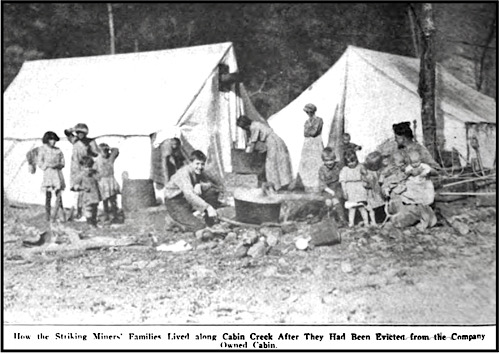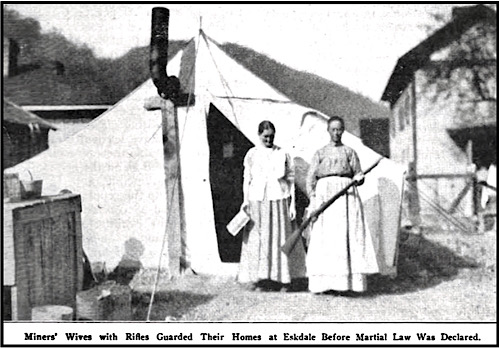 —————
—————
Hellraisers Journal – Saturday January 4, 1913
Cabin Creek, West Virginia – Reports Indicates Some Miners Will Return to Work
From the International Socialist Review of January 1913:
THE CABIN CREEK VICTORY
By JAMES MORTON
Photographs by Paul Thompson.
[Part II of II]
The United Mine Workers’ Journal of December 12 says:
The victory of the union miners at Coalberg, at the mouth of Cabin Creek, is one more step in advance. Some three hundred of the boys will be able to return to work under conditions that they have never enjoyed since the union was destroyed on Cabin Creek in 1904.
But the fight is not yet won.
On Paint Creek, and the great majority of the mines on Cabin Creek, our men are still fighting for an assurance of conditions that will justify them to return to work; conditions that can no longer be claimed impossibly exorbitant by the operators of those mines in the face of the fact that operators, competing with those others, have conceded the scale asked by the miners and expect to conduct their business with profit to themselves.
We, in the organized fields, must remember that there are still thousands of men, women and children evicted from their homes and camped in tents on the hillsides this bleak December weather.
In a little over a week the glad Christmas time will be with us once more.
Let us not forget these brave men and their families, cheerfully suffering untold hardships; uncomplaining, but grateful for what assistance they have already received from their more fortunate brothers.
Remember the bleak, unproductive country in which they have had to make their fight; the fact that their exploitation was so complete while they were still working as to preclude the possibility of any savings of their own; and lastly, the bitter length of the strike, now over eight months; remember their loyalty; not a defection among them; men, women and children, bravely bearing the hardships that necessarily accompany a struggle closely bordering on a state of war.
And so, let us all give what we can possibly spare to help make at least the semblance of Christmas cheer on the bleak hillsides of West Virginia.
We know you have not overly much of the good things of this world. But always it has been the workers who have shown the true spirit of brotherhood by sharing what little they can spare with their less fortunate fellow worker.
The dawn is breaking in West Virginia; but the day is not yet. Let us all strive to make conditions less difficult for our struggling fellow workers.
[Emphasis added.]


